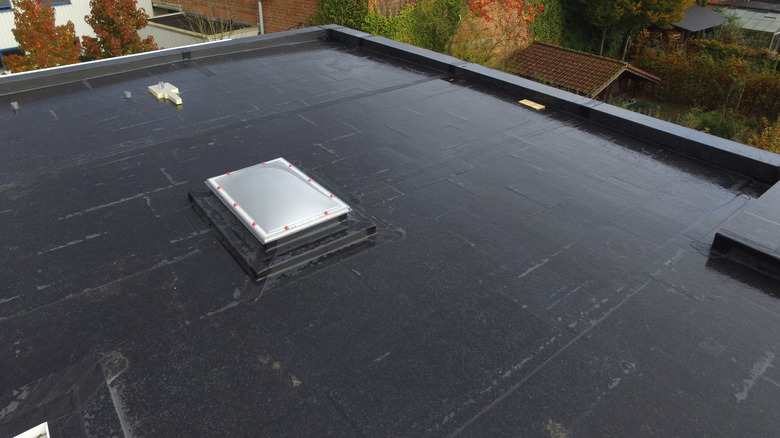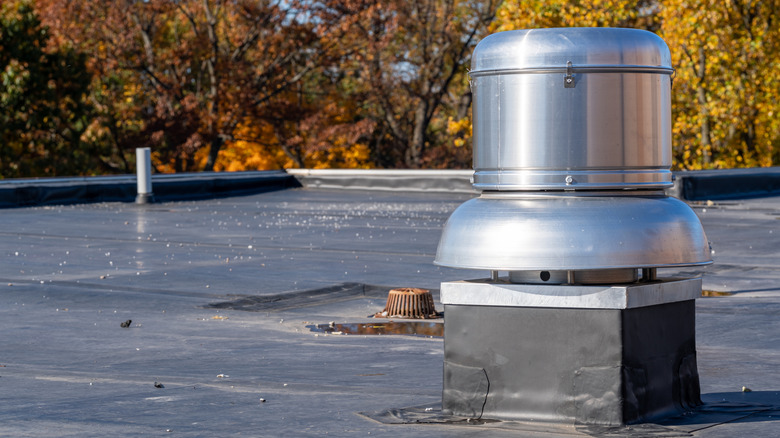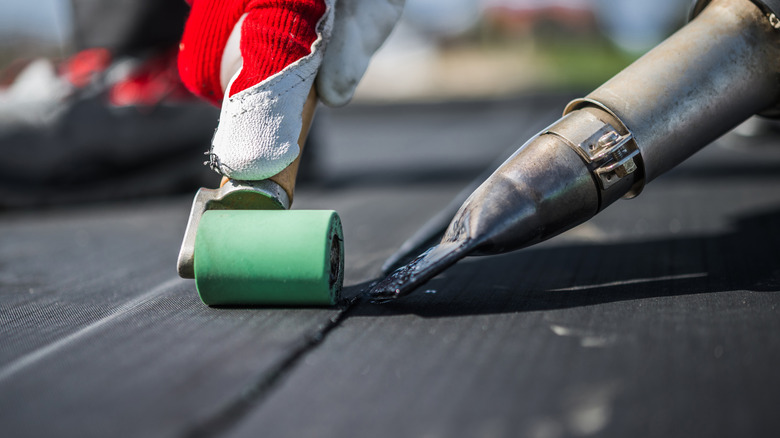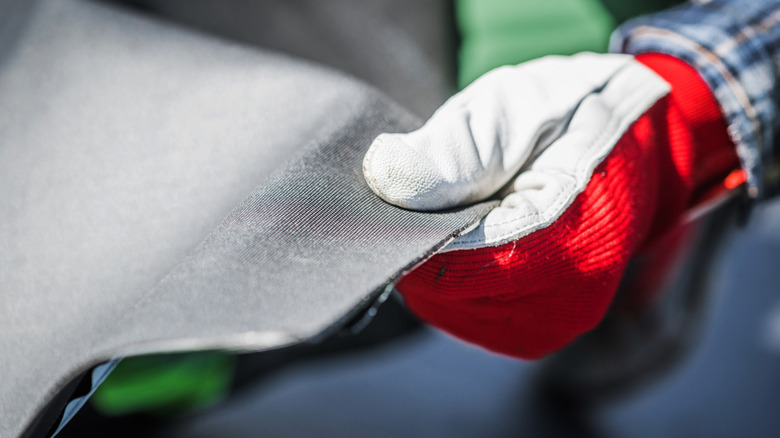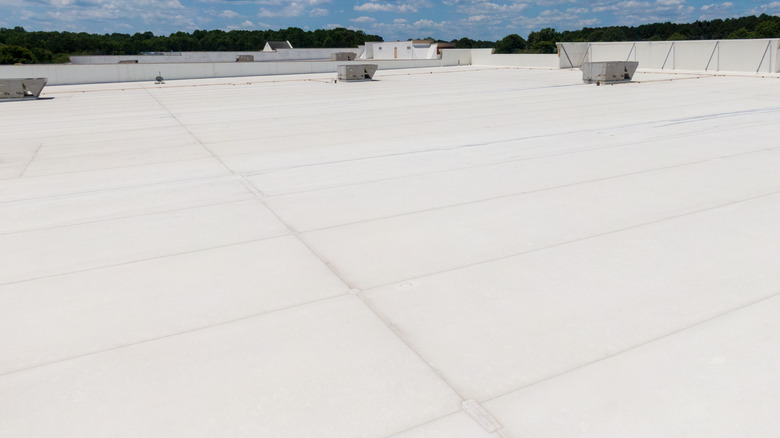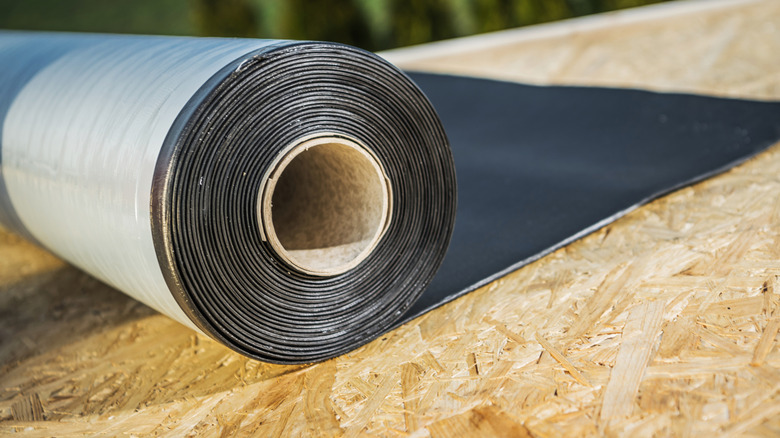The Downsides To EPDM Roofing You Should Know About Before Installing
On average, a roof can last between 25 and 50 years, meaning it's a long-term investment that significantly impacts your property's protection and value. There are several best types of roofing to choose from — options like asphalt shingles and metal roofing are great for sloped roofs. But for flat or low-slope roofs, EPDM roofing is best since its flexible rubber membrane creates an excellent watertight seal — it's designed to handle minimal slopes where water drainage can be challenging for other materials.
Even though there are benefits of EPDM roofing, it's important to understand that it comes with some notable drawbacks. Some downsides to EPDM roofing include aesthetic limitations, shrinkage over time, and severe heat absorption (depending on the color). Other things to be aware of include its susceptibility to punctures and the overall tricky installation. Being fully informed about these potential downsides before committing to an EPDM roof can help you make a more educated decision and avoid unexpected issues down the line.
Aesthetic limitations
Even though your roof is on top of your house, it's a major component of your home's overall curb appeal. EPDM roofing is generally available in black or white, so don't expect to see a broad color palette to match your siding. Because of this, EPDM provides very little room for personalization or unique design statements, unlike some other roofing materials that offer a wider range of colors, textures, or even custom finishes.
Besides the limited color options, EPDM roofing as a whole can look utilitarian or plain compared to other options. Where asphalt shingles offer dimensional texture in a wide array of colors and styles, and metal roofing offers sleek, modern lines, EPDM presents a flat surface with little visual interest. While highly functional and durable, its appearance is often more about practicality than aesthetics, making it less ideal for residential projects where a distinctive look is key.
Shrinkage over time
Unlike other types of roofing, some EPDM roofing can shrink over time. While generally stable, some formulations can show slight shrinkage over extended periods, potentially putting stress on seams and edges. This, in turn, can lead to a compromise of the watertight seal, which significantly increases the risk of leaks, especially at vulnerable points like corners. This shrinkage can also show up in other detrimental ways, like cracking or general splitting, ultimately diminishing the membrane's overall integrity and lifespan.
Your EPDM roofing developing shrinkage issues isn't just an issue for your roof's integrity and the protection of your property — it's an issue for your wallet. This type of roofing generally lasts up to 50 years, but if there's a shrinkage issue, you'll need to repair or replace it much sooner. The costs can quickly add up, from repeated patch repairs to address new leaks as the membrane continues to pull or the substantial cost of a full re-roofing project long before it should be necessary. Ultimately, what was intended to be a long-lasting, low-maintenance solution can turn into an ongoing financial drain if installed incorrectly.
Severe heat absorption
Do you live in a particularly warm climate? If so, you'll want to steer far away from black EPDM roofing. Black EPDM, by default, absorbs heat from the sun. While this can be a minor benefit in very cold climates by slightly reducing heating costs, it becomes a significant drawback in warmer areas. The dark surface can reach extremely high temperatures, often exceeding 160 degrees Fahrenheit, depending on the weather. This, in turn, transfers a substantial amount of that heat into your house. Unfortunately, this can lead to increased cooling costs, reduced HVAC efficiency, and elevated indoor temperatures.
Not only is this heat absorption bad for the inside temperature of your home, but the constant exposure to extreme heat can accelerate the degradation of the EPDM membrane itself. High temperatures contribute to the material's breakdown, potentially leading to premature aging, cracking, and a shorter overall lifespan for your roof. Unfortunately, this negates one of EPDM's primary advantages — its long-term durability.
Susceptibility to punctures
While EPDM is extremely durable, it's not puncture-proof. This material can be easily punctured or torn by sharp objects like debris or a misplaced footstep compared to other materials. This susceptibility to punctures means extra care must be taken during and after installation. If your roof is frequently accessed, such as for skylight maintenance, the risk of accidental damage increases significantly. A small puncture left undetected can lead to leaks, potentially costing you repairs to your home's interior.
The vulnerability that this material brings means you'll need regular inspections, especially after severe weather events or any rooftop activity, to catch potential issues before they escalate into significant water damage. Beyond just the frequency, these regular inspections need to be meticulous. Unlike some other roofing materials, where damage might be more obvious, a small EPDM puncture can be hard to spot without close examination. This might involve visually checking the entire membrane surface for cuts or tears and paying close attention to areas around seams and vents.
Tricky installation
While some roofing materials can be installed as a DIY project (if you have the experience and know-how), EPDM roofing is generally not recommended for DIY installation and should always be left to experienced, certified professionals. This is true for many reasons, but perhaps the biggest is that proper adhesion of the EPDM membrane to the roof deck is crucial for its performance and longevity. This involves correct cleaning, priming, and application of adhesives, which can be sensitive to temperature and moisture. There's no room for error here — doing this incorrectly can lead to bubbling and premature failure.
Additionally, EPDM roofs are installed in large sheets. The most common point of failure is at the seams where these sheets are joined. Making the seam perfectly watertight requires specific techniques and specialized adhesives that home DIYers don't usually have. A poorly installed seam is a guaranteed leak waiting to happen, potentially leading you to costly water damage inside your property. Finally, most EPDM manufacturers' warranties are contingent upon professional installation by certified contractors. Attempting a DIY installation will almost certainly nullify your warranty, leaving you to pay the bill, so before even thinking about this project, consider a few questions to ask a roofing contractor.
